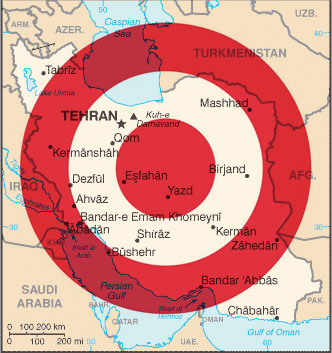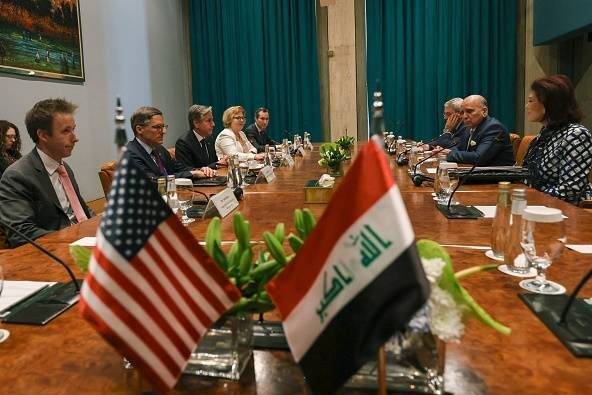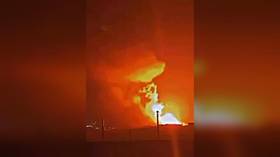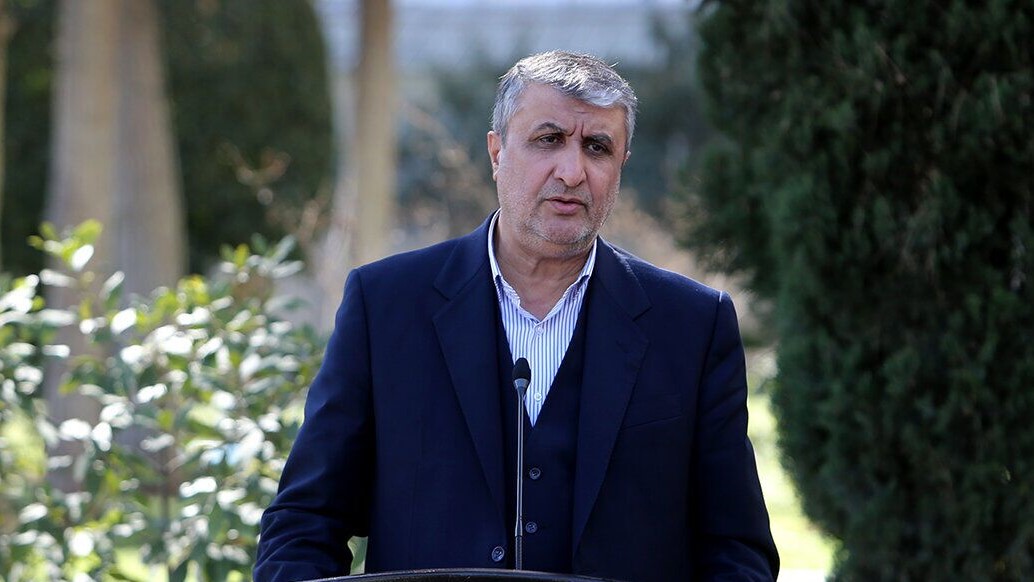NOVANEWS

Part 1: Roots of the Iranian ‘crisis’
by Justin Raimondo
On the front page of a prominent newspaper the news is grim: a Middle Eastern country run by a ruthless dictatorial regime has been secretly developing “weapons of mass destruction.” While in public they deny it, in their underground labs their scientists are busy, cooking up a radioactive horror that will soon be visited upon the world — that is, unless we act.
How do we know this? An exile group of so-called “freedom-fighters” has made this “intelligence” available to a reporter for a widely-read US newspaper, which splashes this scoop all over its front pages.
I could be talking about the year 2002 — or 2012, with only difference being the names of the target countries. We have been down this road before
Israeli Prime Minister Benjamin Netanyahu is now saying it is only a matter of a yearor so before Iran is ready to join the nuclear club — of course, he said the same thinglast year, and the year before, and the year before that.
Adding to our sense of deja-vu, we have an Iranian version of the Iraqi National Congress exile group providing the same quality of “intelligence”: the Mujahideen-e-Khalq (MEK), or Peoples’ Warriors, a weird Marxist-Islamic cult which once served Saddam Hussein and was given a base in Iraq to conduct terrorist activities in Iran. When the southern Shi’ites rose against Saddam in the 1990s, Saddam called in these mercenaries to slaughter the ill-armed rebels. The War Party won a big victory the other day when Hillary Clinton announced the MEK had been taken off the official list of designated terrorist groups. They have been a constant source of phony “evidence” that Iran is secretly working on nuclear weapons
Hardly a day goes by without some supposedly sensational revelation or claim about Iran’s alleged “weapons of mass destruction.” It seems like only yesterday, however, that we were seeing exactly the same headlines, and the same articles, only this time it is Iran instead of Iraq that stands accused. Back in 2002, it was a series of pieces bylined by a New York Times reporter, Judith Miller — whose name has become virtually synonymous with deception. Ms. Miller was being fed her information byChalabi’s group, via her close connections to the administration, and in particular to a group of political operatives deemed the neoconservatives.
This was — is — a small but highly influential coterie of what used to be called cold war liberals, whose views were shaped by migratory ex-Trotskyites with a bone to pick with Stalin. Not your run of the mill European-style Social Democrats, mind you, but militant interventionists with a vision of a world reshaped by American military power. Or, as one neocon writing in a prominent foreign policy journal put it: the goal of US foreign policy ought to be “benevolent global hegemony” — as opposed, one must assume, to the malevolent global hegemony dreamed of by Communists, national socialists, and other villains throughout history.
The fabled journey of the neocons from far left to far right has been celebrated in story and song, and there is no need to go into all the gory details here: we’ve heard it all before — in a PBS documentary, “Arguing the World,” and in numerous memoirs by the participants. Yet this famous hegira didn’t take them anywhere: it was a journey standing still. For they had simply transferred their allegiance from the Soviet Union to the United States without changing the basic underlying assumptions of their radical universalism: instead of a world communist revolution as advocated by Leon Trotsky and his followers, these disillusioned Marxists now dreamed of a “global democratic revolution,” as one of George W. Bush’s speechwriters put it in a presidential oration celebrating the anniversary of the National Endowment for Democracy.
Having walked out of the Democratic party, disgusted with the alleged “pacifism” of George McGovern, these Scoop Jackson Democrats wound up in the Republican party just as the Reagan Revolution, so-called, was picking up steam. When Reagan went to Washington, the neocons followed in his wake, and wound up ensconced in theNational Endowment for Democracy, which was founded with them in mind. There Reagan’s advisers could keep an eye on them, while they stayed largely out of sight of the general public.
From a small coterie of social democratic intellectuals, the neocons soon branched outand established a Washington network that tied them into the right-wing cold war coalition of social conservatives, free market types, and professional anti-communists. The neocons fit neatly into the latter category, but were never quite comfortable with the other members of the coalition.
Some of them remained socialists, or at least social democrats of one sort or another, and as far as capitalism was concerned, they could only give it two cheers, at the most — as Irving Kristol put it in the title of one of his books. When it came to domestic issues, the neocons were all over the map, fromSidney Hook — the quintessential New York intellectual — who remained a socialist until his dying day, to Irving Kristol, a former Trotksyist who wound up founding a veritable dynasty based on the ideological assumptions to be found in the Republican party platform.
What unified them, and defined them as a cohesive group, was a fanatical hatred of Stalinism and their dedication to the idea of spreading democracy — at gunpoint, if necessary — throughout the world. During the cold war, the CIA made use of them as the US sought to counter Soviet influence on the international left. Having displacedthe older generation of conservatives, who were derided as “isolationists,” these New Conservatives — or neoconservatives, as they came to be known — came to dominate the American right-wing and soon seized control of the philanthropic foundations that poured money into right-wing causes.
As the cold war ended, however, they saw their influence waning. When Reagan met with Gorbachev and signed a treaty limiting long-range missiles based in Europe, theyaccused the man who had coined the phrase “evil empire” with selling out to the commies and leaving the US defenseless against the Kremlin. They failed to understand what was happening when the Soviet colossus began to crack because they never “got it” that communism’s biggest enemies were its own internal contradictions.
With the fall of Communism, and the dissolution of the Warsaw Pact, the professional anti-communists were out of work. Suddenly there was a big hole in their worldview: the rationalization for our interventionist foreign policy had disappeared almost overnight. Worse, from their point of view, the Republicans were drifting back to their “isolationist” roots. When, during the Clinton administration, the Republicans in Congress threatened to pull the funding from our military adventure in Kosovo, Bill Kristol, editor of the Weekly Standard, threatened to walk out of the Republican party.
Ah, but all was not lost. When George W. Bush went to Washington, a gaggle of neocons followed him. Showing up for work that fateful winter were all the familiar faces who had worked for Sen. Scoop Jackson (D-Boeing), organized the Committee on the Present Danger (and other neocon front groups), and served as the de facto command center of the War Party in previous administrations: Paul Wolfowitz,Richard Perle, Eliot Cohen, Elliott Abrams, Douglas Feith — and, sitting in the peanut gallery, the neocon publicists like Bill Kristol, son of Irving, editor of the Weekly Standard: Max Boot, former CIA analyst, the gang over at Commentary magazine, the staff of the American Enterprise Institute — the most prominent and certainly the wealthiest conservative think tank — and various and sundry Republican politicians, as well as ostensible Democrats like Sen. Joe Lieberman. The policy office of the Pentagon and the National Security Council were packed with neocons, and they hadtheir agenda all set to go when George W. Bush entered the Oval Office.
They went to Washington with a plan: invade and subjugate Iraq. They had found a new enemy to take the place of the Kremlin, and it wasn’t just the Iraq dictator — although Saddam was their initial target — but the entire Muslim world, which they determined had to be transformed. The “swamp,” they averred, had to be “drained.” In their view, the entire Arab world had been deformed and kept back from achieving “modernity” due to certain characteristics of what they called the “Arab mind” — deformations that could be traced back to the all-pervasive influence of Islam on the development of Arab civilization.
The stage was set for the disaster that was about to unfold….
How do we know this? An exile group of so-called “freedom-fighters” has made this “intelligence” available to a reporter for a widely-read US newspaper, which splashes this scoop all over its front pages.
I could be talking about the year 2002 — or 2012, with only difference being the names of the target countries. We have been down this road before
Israeli Prime Minister Benjamin Netanyahu is now saying it is only a matter of a yearor so before Iran is ready to join the nuclear club — of course, he said the same thinglast year, and the year before, and the year before that.
Adding to our sense of deja-vu, we have an Iranian version of the Iraqi National Congress exile group providing the same quality of “intelligence”: the Mujahideen-e-Khalq (MEK), or Peoples’ Warriors, a weird Marxist-Islamic cult which once served Saddam Hussein and was given a base in Iraq to conduct terrorist activities in Iran. When the southern Shi’ites rose against Saddam in the 1990s, Saddam called in these mercenaries to slaughter the ill-armed rebels. The War Party won a big victory the other day when Hillary Clinton announced the MEK had been taken off the official list of designated terrorist groups. They have been a constant source of phony “evidence” that Iran is secretly working on nuclear weapons
Hardly a day goes by without some supposedly sensational revelation or claim about Iran’s alleged “weapons of mass destruction.” It seems like only yesterday, however, that we were seeing exactly the same headlines, and the same articles, only this time it is Iran instead of Iraq that stands accused. Back in 2002, it was a series of pieces bylined by a New York Times reporter, Judith Miller — whose name has become virtually synonymous with deception. Ms. Miller was being fed her information byChalabi’s group, via her close connections to the administration, and in particular to a group of political operatives deemed the neoconservatives.
This was — is — a small but highly influential coterie of what used to be called cold war liberals, whose views were shaped by migratory ex-Trotskyites with a bone to pick with Stalin. Not your run of the mill European-style Social Democrats, mind you, but militant interventionists with a vision of a world reshaped by American military power. Or, as one neocon writing in a prominent foreign policy journal put it: the goal of US foreign policy ought to be “benevolent global hegemony” — as opposed, one must assume, to the malevolent global hegemony dreamed of by Communists, national socialists, and other villains throughout history.
The fabled journey of the neocons from far left to far right has been celebrated in story and song, and there is no need to go into all the gory details here: we’ve heard it all before — in a PBS documentary, “Arguing the World,” and in numerous memoirs by the participants. Yet this famous hegira didn’t take them anywhere: it was a journey standing still. For they had simply transferred their allegiance from the Soviet Union to the United States without changing the basic underlying assumptions of their radical universalism: instead of a world communist revolution as advocated by Leon Trotsky and his followers, these disillusioned Marxists now dreamed of a “global democratic revolution,” as one of George W. Bush’s speechwriters put it in a presidential oration celebrating the anniversary of the National Endowment for Democracy.
Having walked out of the Democratic party, disgusted with the alleged “pacifism” of George McGovern, these Scoop Jackson Democrats wound up in the Republican party just as the Reagan Revolution, so-called, was picking up steam. When Reagan went to Washington, the neocons followed in his wake, and wound up ensconced in theNational Endowment for Democracy, which was founded with them in mind. There Reagan’s advisers could keep an eye on them, while they stayed largely out of sight of the general public.
From a small coterie of social democratic intellectuals, the neocons soon branched outand established a Washington network that tied them into the right-wing cold war coalition of social conservatives, free market types, and professional anti-communists. The neocons fit neatly into the latter category, but were never quite comfortable with the other members of the coalition.
Some of them remained socialists, or at least social democrats of one sort or another, and as far as capitalism was concerned, they could only give it two cheers, at the most — as Irving Kristol put it in the title of one of his books. When it came to domestic issues, the neocons were all over the map, fromSidney Hook — the quintessential New York intellectual — who remained a socialist until his dying day, to Irving Kristol, a former Trotksyist who wound up founding a veritable dynasty based on the ideological assumptions to be found in the Republican party platform.
What unified them, and defined them as a cohesive group, was a fanatical hatred of Stalinism and their dedication to the idea of spreading democracy — at gunpoint, if necessary — throughout the world. During the cold war, the CIA made use of them as the US sought to counter Soviet influence on the international left. Having displacedthe older generation of conservatives, who were derided as “isolationists,” these New Conservatives — or neoconservatives, as they came to be known — came to dominate the American right-wing and soon seized control of the philanthropic foundations that poured money into right-wing causes.
As the cold war ended, however, they saw their influence waning. When Reagan met with Gorbachev and signed a treaty limiting long-range missiles based in Europe, theyaccused the man who had coined the phrase “evil empire” with selling out to the commies and leaving the US defenseless against the Kremlin. They failed to understand what was happening when the Soviet colossus began to crack because they never “got it” that communism’s biggest enemies were its own internal contradictions.
With the fall of Communism, and the dissolution of the Warsaw Pact, the professional anti-communists were out of work. Suddenly there was a big hole in their worldview: the rationalization for our interventionist foreign policy had disappeared almost overnight. Worse, from their point of view, the Republicans were drifting back to their “isolationist” roots. When, during the Clinton administration, the Republicans in Congress threatened to pull the funding from our military adventure in Kosovo, Bill Kristol, editor of the Weekly Standard, threatened to walk out of the Republican party.
Ah, but all was not lost. When George W. Bush went to Washington, a gaggle of neocons followed him. Showing up for work that fateful winter were all the familiar faces who had worked for Sen. Scoop Jackson (D-Boeing), organized the Committee on the Present Danger (and other neocon front groups), and served as the de facto command center of the War Party in previous administrations: Paul Wolfowitz,Richard Perle, Eliot Cohen, Elliott Abrams, Douglas Feith — and, sitting in the peanut gallery, the neocon publicists like Bill Kristol, son of Irving, editor of the Weekly Standard: Max Boot, former CIA analyst, the gang over at Commentary magazine, the staff of the American Enterprise Institute — the most prominent and certainly the wealthiest conservative think tank — and various and sundry Republican politicians, as well as ostensible Democrats like Sen. Joe Lieberman. The policy office of the Pentagon and the National Security Council were packed with neocons, and they hadtheir agenda all set to go when George W. Bush entered the Oval Office.
They went to Washington with a plan: invade and subjugate Iraq. They had found a new enemy to take the place of the Kremlin, and it wasn’t just the Iraq dictator — although Saddam was their initial target — but the entire Muslim world, which they determined had to be transformed. The “swamp,” they averred, had to be “drained.” In their view, the entire Arab world had been deformed and kept back from achieving “modernity” due to certain characteristics of what they called the “Arab mind” — deformations that could be traced back to the all-pervasive influence of Islam on the development of Arab civilization.
The stage was set for the disaster that was about to unfold….



